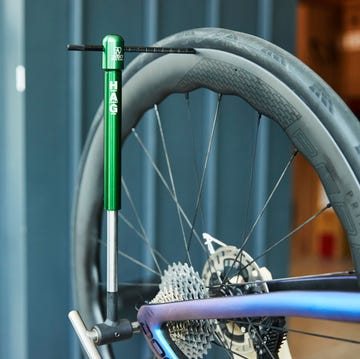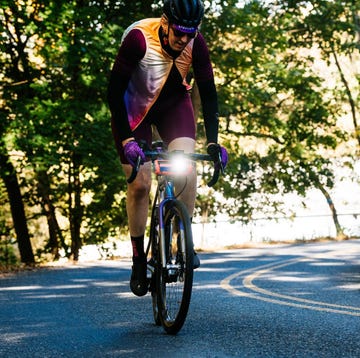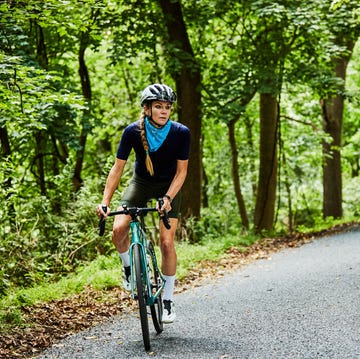Proper bike seat height—along with overall bike fit—is one of the most important measurements to get right. The correct saddle height for your physiology is crucial if you want to ride comfortably and stay ache- and injury-free.
Dialing in the ideal saddle height on your bike is also super important for keeping your knees happy. It is often the case that knee pain while cycling is caused, at least in part, by riding with the wrong saddle height. And this is true whether you're racing or just aiming for bragging rights at your local Tour de Coffee Shop.
The fact is, an ill-fitting bike is an invitation to pain, injuries, frustration, and poor performance.
Remember: Your ideal riding position results from adjusting your bike to fit your body, not the other way around. Saddle height adjustment has always been a bit of a dark art, but in general, it is the distance between the center of the bottom bracket and top/center of your bike saddle.
Your local bike shop can determine your bike seat height scientifically, but here’s a quick and simple way to estimate it. Once you are dialed into your fit, you’ll become more comfortable (and maybe even faster) on your bike.
6 Tips for Determining the Ideal Height of Your Bike Saddle
1. Look to Your Stem
Position your stem so that the top of your handlebar is about an inch below the top of your saddle. Aspiring racers may want a slightly lower position for aerodynamics, while touring cyclists may opt for a more upright posture to take some pressure off the lower back. As always, listen to your body and adjust your bike accordingly.
2. Find Your Leg Positioning
There are various formulas for determining bike saddle height, but you needn’t be a mathematician to achieve the correct height. Your knees should be slightly bent at the bottom of the pedal stroke, and when pedaling, your hips should not rock on the saddle (when viewed from behind). To determine this, we recommend mounting your bike in a trainer or leaning it against a wall (as shown in the video above).
If your saddle height is correct, your heel should just graze the pedal at the bottom of the pedal stroke (in the 6 o’clock position).
When riding, if you encounter pain at the front of your knee, raise the saddle slightly. If you have pain in the back of the knee, drop the saddle. Make saddle height changes 2 mm at a time to avoid leg and knee strain.
3. Do Some Math
If you are using clipless pedals, you can also use a mathematical formula. Here’s how: Stand barefoot on a hard floor, back to a wall, with a book snugged up between your thighs, spine facing the ceiling. Measure from the floor to the top of the book spine in millimeters.
Multiply that number by 0.883, and subtract 4mm. The result is your proper bike seat height, measured from the center of the bottom bracket to the top of the seat, along the seat tube.
4. Check Fore/Aft Position
To determine fore/aft saddle position, sit comfortably in the center of the saddle with the crankarms horizontal. Drop a plumb line from the front of your forward kneecap. It should touch the end of the crankarm. This is the neutral position, and you should be able to achieve it by loosening the seatpost clamp and sliding the saddle fore or aft.
Climbers, time trialists, and some road racers prefer the line to fall a centimeter or two behind the end of the crankarm to increase leverage in big gears. Conversely, track and criterium racers like a more forward position to improve leg speed. Remember, if your reach to the handlebar is wrong, use stem length to correct it, not fore/aft saddle position.
5. Determine Your Reach
The combined dimensions of top tube and stem length, which determine your “reach,” vary according to your flexibility and anatomy. While there is no end-all answer, don’t be afraid to spend a little time and money to find the right mix. This measurement, more than any other on your bike, will dictate your comfort level.
A good starting point: When you’re comfortably seated with elbows slightly bent and hands on the brake hoods, the front hub should be obscured by the handlebar. This is a relatively upright position. With time, you may want to swap in a longer stem to improve aerodynamics and flatten your back, especially if you get into racing.
6. Make Sure You’re Level
Your saddle should be level, which you can check by laying a straightedge along its length, or try one of the free leveling apps that can be downloaded onto most smartphones. A slight downward tilt may be more comfortable if you’re using an extreme forward position with an aerodynamic bar and elbow rests. But too much tilt causes you to slide forward, placing excessive weight on your arms.
—Adapted from Bicycling’s 1,100 Best All-Time Tips












